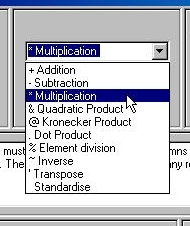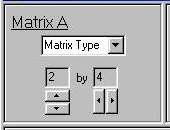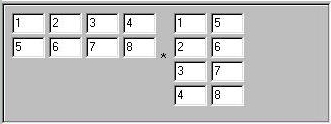Behavioural Genetic Interactive Modules
Matrices

Overview
This module aims to familiarise individuals with some
of the common operations in matrix algebra.
Tutorial
This module allows the user to perform some of the
more common matrix operations, such as matrix addition,
multiplication, inversion and transposition. Some of these
functions operate on only one matrix, such as inversion,
whereas some take two matrices to produce a resulting
matrix, such as addition. Also, certain operations require
the matrix or matrices to have certain properties, such as
being square, of having nonzero diagonal elements.
 Firstly, select the type of matrix operation you wish to
perform: use the pull-down menu in the top-middle of the
screen. For example, we choose to multiply two matrices
together in this instance. As matrix multiplication is a
function that takes two matrices to produce a resulting
product matrix, both matrices A and B remain on screen.
Matrix B will disappear if a function is selected that requires
only one matrix (these are called unary functions, as opposed
to binary functions).
Firstly, select the type of matrix operation you wish to
perform: use the pull-down menu in the top-middle of the
screen. For example, we choose to multiply two matrices
together in this instance. As matrix multiplication is a
function that takes two matrices to produce a resulting
product matrix, both matrices A and B remain on screen.
Matrix B will disappear if a function is selected that requires
only one matrix (these are called unary functions, as opposed
to binary functions).
 We can define the sizes of matrices A and B using the arrows
in the Matrix A and Matrix B panels. The maximum number of
rows and columns is four. Also, certain predefined types of
matrix can be selected from the pull-down menu in each
panel. [Not operational yet]
We can define the sizes of matrices A and B using the arrows
in the Matrix A and Matrix B panels. The maximum number of
rows and columns is four. Also, certain predefined types of
matrix can be selected from the pull-down menu in each
panel. [Not operational yet]
The different types of matrix are described below :
- Full
- Every element can be any value. For example, here is a
full 2-by-2 matrix:
- Lower Triangular
- Only the elements on the diagonal and below are
represented (the others are assumed to be zero).
Such a representation is commonly used to
symmetric matrices also (the other elements are
assumed to be identical to the below-diagonal
elements). Here is a 3-by-3 lower triangular matrix:
| 0.23 | | |
| 0.12 | 0.52 | |
| 0.76 | 0.14 | 0.73 |
- Diagonal
- All off-diagonal elements are zero:
- Zero
- All elements are zero:
- Unit
- All elements are one:
- Identity
- All diagonal elements are 1, all off-diagonal elements
are zero.
 Upon selecting the type of function, some text will be displayed
in the middle window, telling the user whether or not there
are any special conditions required for that type of operation.
In this case, for multiplication to be possible between
two matrices (we say that they are conformable for
multiplication) the first matrix must have the same number
of columns as the second matrix has rows.
Upon selecting the type of function, some text will be displayed
in the middle window, telling the user whether or not there
are any special conditions required for that type of operation.
In this case, for multiplication to be possible between
two matrices (we say that they are conformable for
multiplication) the first matrix must have the same number
of columns as the second matrix has rows.
Different functions have different requirements:
- Addition
- Both matrices must be exactly the same size
- Subtraction
- Both matrices must be exactly the same size
- Multiplication
- Matrix A must have as many columns as Matrix B
has rows
- Quadratic Product
- Matrix B must be square and have the same number of
columns as Matrix A does
- Kronecker Product
- Technically no restrictions, although in this module,
the resulting matrix cannot be larger than a 4-by-4 matrix
- Dot Product
- Both matrices must be exactly the same size
- Element Division
- Both matrices must be exactly the same size
- Inversion (unary operation)
- The matrix must be square and positive-definite.
For this module, we only calculate the inverse of
symmetric matrices, also - the module only looks
at the lower triangular elements.
- Transposition (unary operation)
- No restrictions
- Standardisation (unary operation)
- The matrix must be square and not have any zeros
along the diagonal
 Let's consider the example of matrix multiplication. We know that
Matrix A must have the same number of columns as Matrix B has rows.
In this case, Matrix A has 2 rows and 4 columns, whereas Matrix B
has 4 rows and 2 columns. They are conformable for multiplication.
The resulting matrix will have as many rows as matrix A and as
many columns as matrix B. It is always common to write the
number of rows before columns when talking about the
dimension of a matrix. Therefore :
Let's consider the example of matrix multiplication. We know that
Matrix A must have the same number of columns as Matrix B has rows.
In this case, Matrix A has 2 rows and 4 columns, whereas Matrix B
has 4 rows and 2 columns. They are conformable for multiplication.
The resulting matrix will have as many rows as matrix A and as
many columns as matrix B. It is always common to write the
number of rows before columns when talking about the
dimension of a matrix. Therefore :
Matrix A Matrix B
R C R C
2 4 4 2
| | equal? | |
| |---------| |
| |
|-----------------|
dimension of product
The two inner numbers must be equal, the resulting
matrix has the dimension given by the two outer numbers.
 In our example, we expect a 2-by-2 matrix to
result, therefore. Matrix multiplication is introduced
in the Appendix: remember that the basic principle is
that the ith, jth element in the
resulting matrix is the sum of the products of all
the elements in the ith row in Matrix A
with the corresponding element in the jth
column of Matrix B. In this case:
In our example, we expect a 2-by-2 matrix to
result, therefore. Matrix multiplication is introduced
in the Appendix: remember that the basic principle is
that the ith, jth element in the
resulting matrix is the sum of the products of all
the elements in the ith row in Matrix A
with the corresponding element in the jth
column of Matrix B. In this case:
- 30 = 1*1 + 2*2 + 3*3 + 4*4
- 70 = 5*1 + 6*2 + 7*3 + 8*4
- 70 = 1*5 + 2*6 + 3*7 + 4*8
- 174 = 5*5 + 6*6 + 7*7 + 8*8
Different matrix operations
Matrix multiplication seems quite different to
usual multiplication. The equivalent of 'normal'
multiplication is called the dot product, where
the [i,j] element of matrix A is multiplied by
the [i,j] element of matrix B to give the
[i,j] element of the resulting matrix.
[This is Mx's definition of a
dot product]
Element division is similar to the dot product in
this respect. The matrix equivalent of division is
concerned with the operation called inversion.
This is because
I = A * A~
where I is an identity matrix, A is
a symmetric, square matrix and A~ is its inverse.
This is the definition of a reciprocal, that is the inverse
represents, in non-matrix notation, 1/a. Try this with some
real numbers using the module. That is, make up a square
symmetric matrix, calculate its inverse, then multiply
the matrix by its inverse. Ignoring rounding errors, the
resulting matrix will always be an identity matrix.
The transpose of a matrix (X') simply turns a matrix on its side:
all the rows become columns and all the columns become rows.
This is often useful in matrix operations. The equivalent of
'squaring' a lower triangular is X*X'.
As covered in the Appendix, we can also standardise matrices,
by dividing the [i,j] elements by the square root of the product
of elements [i,i] and [j,j]. This has the effect of making
all diagonal elements 1. In this case of a covariance matrix,
standardisation will produce a correlation matrix, where all the
off diagonal elements are less then 1.
The quadratic product and Kronecker product are not
covered in this tutorial, nor implemented in the
module yet.
Questions
- What other differences are there between normal
multiplication and matrix multiplication? For
example, is matrix A multiplied by matrix B the
same as matrix B multiplied by matrix A ?
-
-
Answers
-
-
-
Site created by S.Purcell, last updated 6.11.2000
|

 Firstly, select the type of matrix operation you wish to
perform: use the pull-down menu in the top-middle of the
screen. For example, we choose to multiply two matrices
together in this instance. As matrix multiplication is a
function that takes two matrices to produce a resulting
product matrix, both matrices A and B remain on screen.
Matrix B will disappear if a function is selected that requires
only one matrix (these are called unary functions, as opposed
to binary functions).
Firstly, select the type of matrix operation you wish to
perform: use the pull-down menu in the top-middle of the
screen. For example, we choose to multiply two matrices
together in this instance. As matrix multiplication is a
function that takes two matrices to produce a resulting
product matrix, both matrices A and B remain on screen.
Matrix B will disappear if a function is selected that requires
only one matrix (these are called unary functions, as opposed
to binary functions). We can define the sizes of matrices A and B using the arrows
in the Matrix A and Matrix B panels. The maximum number of
rows and columns is four. Also, certain predefined types of
matrix can be selected from the pull-down menu in each
panel. [Not operational yet]
We can define the sizes of matrices A and B using the arrows
in the Matrix A and Matrix B panels. The maximum number of
rows and columns is four. Also, certain predefined types of
matrix can be selected from the pull-down menu in each
panel. [Not operational yet]  Upon selecting the type of function, some text will be displayed
in the middle window, telling the user whether or not there
are any special conditions required for that type of operation.
In this case, for multiplication to be possible between
two matrices (we say that they are conformable for
multiplication) the first matrix must have the same number
of columns as the second matrix has rows.
Upon selecting the type of function, some text will be displayed
in the middle window, telling the user whether or not there
are any special conditions required for that type of operation.
In this case, for multiplication to be possible between
two matrices (we say that they are conformable for
multiplication) the first matrix must have the same number
of columns as the second matrix has rows.
 Let's consider the example of matrix multiplication. We know that
Matrix A must have the same number of columns as Matrix B has rows.
In this case, Matrix A has 2 rows and 4 columns, whereas Matrix B
has 4 rows and 2 columns. They are conformable for multiplication.
The resulting matrix will have as many rows as matrix A and as
many columns as matrix B. It is always common to write the
number of rows before columns when talking about the
dimension of a matrix. Therefore :
Let's consider the example of matrix multiplication. We know that
Matrix A must have the same number of columns as Matrix B has rows.
In this case, Matrix A has 2 rows and 4 columns, whereas Matrix B
has 4 rows and 2 columns. They are conformable for multiplication.
The resulting matrix will have as many rows as matrix A and as
many columns as matrix B. It is always common to write the
number of rows before columns when talking about the
dimension of a matrix. Therefore :
 In our example, we expect a 2-by-2 matrix to
result, therefore. Matrix multiplication is introduced
in the Appendix: remember that the basic principle is
that the ith, jth element in the
resulting matrix is the sum of the products of all
the elements in the ith row in Matrix A
with the corresponding element in the jth
column of Matrix B. In this case:
In our example, we expect a 2-by-2 matrix to
result, therefore. Matrix multiplication is introduced
in the Appendix: remember that the basic principle is
that the ith, jth element in the
resulting matrix is the sum of the products of all
the elements in the ith row in Matrix A
with the corresponding element in the jth
column of Matrix B. In this case: